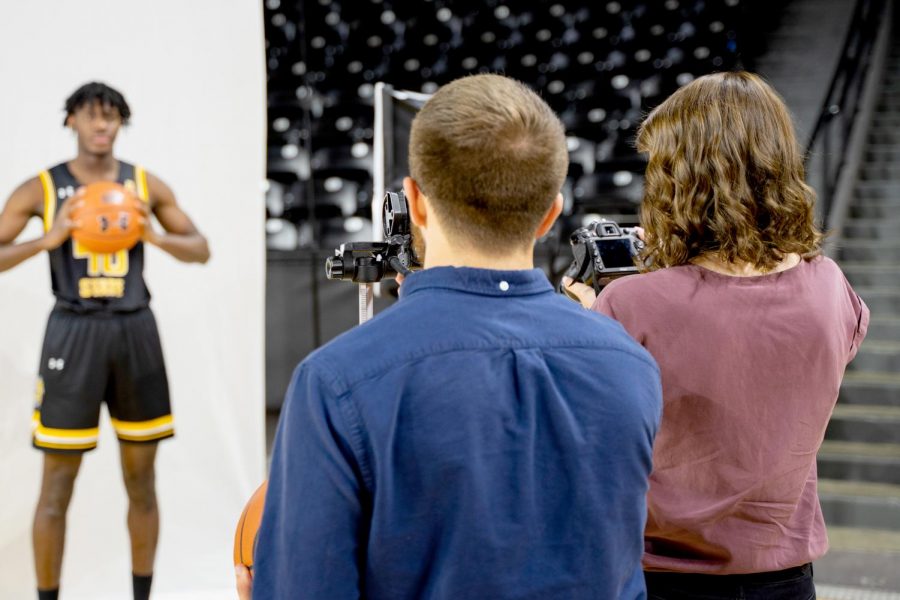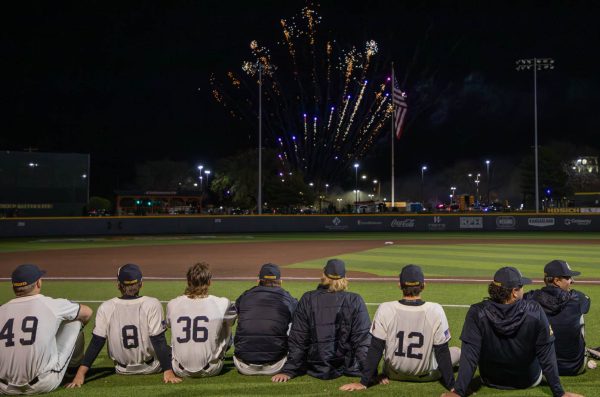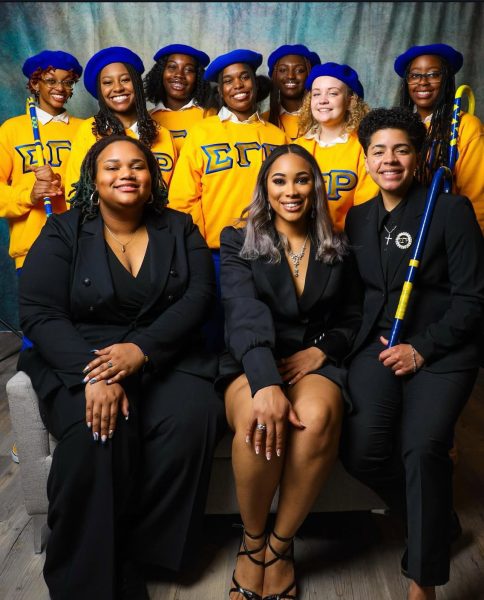A Woman’s World: It’s 2020, normalize women covering men’s sports
Sunflower photographers Easton Thompson and Morgan Anderson cover men’s basketball media day on Oct. 15, 2019 inside Charles Koch Arena.
Imagine this: you’re on your way to your first major college sporting event. Five years of hard work and practice has prepared you for this moment — you are finally at the top. Men’s basketball awaits.
Computer on your back and camera bag on your shoulder, you walk through the darkened media tunnel and step into the arena. You’re surrounded – the lights, the thousands of fans, the players warming up. You take it all in. You’ve officially made it.
Retrieving your camera, you scan the floor for your spot and you notice the blue tape and the sharpie-written words that read, “The Sunflower”. The feeling of excitement is an understatement.
You begin to capture pre-game photos and test the lighting. Everything must be perfect. As a freshman, you have one chance to prove yourself that you can cover something as important as men’s basketball, and you don’t want to ruin your chances of covering it ever again.
Finally, the buzzer sounds and it’s time for the game to start. You sit down on your space on the floor next to nine other photographers — strangers, who all work for different media outlets. You hear the first whistle and the game is in play. Snapping away like your life depends on it, you capture every move, every play, and every shot. It’s exhilarating and it feels like a dream.
That is until you notice your surroundings once more. This time, in more detail.You’re the only woman. . You glance across the floor to the other media spaces on the other side and it’s the same. All men.
You are alone.
Now, let me ask you a question. How do you feel about women covering men’s sports?
I’ve been given two different responses every time I’ve asked this. I get the “Sure, why not? Women are just as capable.” But, more often than I should, I get a hesitant shrug and the occasional comment saying, “Well, I don’t know. Men know more about sports anyway.”
This common misconception that women are unable to understand the inner workings of sports, especially men’s sports, has undermined women like myself who are passionate about covering such events.
Sports broadcasting has always been a heavily male dominated field. According to a recent study done in 2017, men make up around 90% of editors, broadcasters, and commentators while women make up the other 10%. This statistic, though shocking to some, didn’t surprise me in the least.
This leaves me with questions. Is this discrimination? Or perhaps do women feel as though they don’t have a chance? When the norm has always been men, it’s difficult to change the minds of those who are used to being comfortable.
As a woman who works in the media field, I understand the difficulties that women face when working in the sports industry. I am one of them. I feel as though I must work harder to show that I am capable of covering men’s sports just as well as my male colleagues. We have this stereotype that we view sports as a joke, so we almost have to work twice as hard in order to be taken seriously.
If you take a look at the women covering and broadcasting sports in the 21st century, you will also notice that they are all good-looking. And this is not my personal opinion. Tina Cervasio, a Fox’s New York affiliate reporter, said in an interview, “They’re worried about color of hair and how a woman looks… if I was as fat and bald as [some male sportscasters], I would not have that job.”
You could have years of experience and a stunning resume, but if you aren’t “pretty” enough, you’ve already lost your chance. This is yet another way men, knowingly or not, discriminate against women who try to step into their “boys-only club”.
Take Debbie Antonelli’s story as another example. Antonelli became the first woman since 1995 to be an NCAA men’s tournament analyst in 2017. Prior to getting the job, she spent 29 years as a sideline reporter, worked for the WNBA, ESPN, and broadcasted the ACC men’s tournament. She had years of experience, and was, as it seems, over qualified. So why did it take so long for her to get noticed?
Women simply have more rules and expectations than men when it comes to covering sports. This isn’t to say that men don’t have to work just as hard to be successful in the sports media industry, but there are less hoops to jump through. If women aren’t given the chance to show their abilities, there isn’t room for change.
So what’s the solution? It’s easier than you think.
Have an open mind. Allow that opportunity for women to show that they are able to be play-by-play reporters, analysts, and broadcasters. This will delete the stereotype that has been in place for far too long. Men, I urge you to speak out and be a part of breaking down the barriers that prevent women from having the same opportunities. Encourage them to work towards their goals instead of demoralizing them into thinking that they should try a different career path.
Sports coverage isn’t just a man’s world, it’s also a woman’s. It’s time to level the playing field.

Morgan Anderson is the former Managing Editor for The Sunflower. Anderson grew up in Sterling, Kansas and is a sophomore majoring in communications with...









